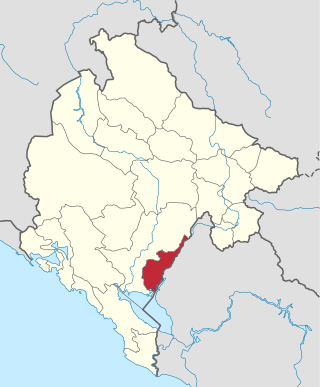Muslims is a designation for the ethnoreligious group of Serbo-Croatian-speaking Muslims and people of Muslim heritage, inhabiting mostly the territory of the former Socialist Federal Republic of Yugoslavia. The term, adopted in the 1971 Constitution of Yugoslavia, groups together a number of distinct South Slavic communities of Islamic ethnocultural tradition. Prior to 1993, a vast majority of present-day Bosniaks self-identified as ethnic Muslims, along with some smaller groups of different ethnicity, such as Gorani and Torbeši. This designation did not include Yugoslav non-Slavic Muslims, such as Albanians, Turks and Roma.

Montenegrins are a South Slavic ethnic group that share a common Montenegrin culture, history, and language, identified with the country of Montenegro.
The demographic history of Montenegro can be shown through census results and official documents which mention demographic composition.

Kula is a town and municipality located in the West Bačka District of the autonomous province of Vojvodina, Serbia. The town has a population of 17,866, while the municipality has a population of 43,101.

This article is about the demographic features of the population of Montenegro, including population density, ethnicity, education level, health of the populace, economic status, religious affiliations and other aspects of the population.

Religion in Montenegro refers to adherents, communities, institutions and organizations of various religions in Montenegro. While Eastern Orthodox Christianity is the dominant religious denomination in Montenegro, there are also sizable numbers of adherents of both Catholic Christianity and Islam.
Serbs and Montenegrins (Serbs-Montenegrins) are an ethno-linguistic community in Albania. They are one of the recognized national minorities. The population was concentrated in the region of Vraka, but largely emigrated in the 1990s. The community is bilingual and by majority adhere to Eastern Orthodoxy, while a minority professes Islam. The majority of the Serbo-Montenegrin community came to Albania from Montenegro during the interwar Zogist period following 1926 and later from 1938 until 1948. In the latest census (2011) 366 citizens declared themselves as Montenegrins and 142 as Serbs.

The geographical distribution of speakers of Macedonian refers to the total number of native speakers of Macedonian, an East South Slavic language that serves as the official language of North Macedonia. Estimates of the number of native and second language speakers of Macedonian varies; the number of native speakers in the country ranges from 1,344,815 according to the 2002 census in North Macedonia to 1,476,500 per linguistic database Ethnologue in 2016. Estimates of the total number of speakers in the world include 3.5 million people. Macedonian is studied and spoken as a second language by all ethnic minorities in the country.

Turks in Montenegro, also known as Turkish Montenegrins and Montenegrin Turks, are ethnic Turks who form an ethnic minority in Montenegro.
Vusanje is a village in Gusinje Municipality, Montenegro. According to the 2003 census, the town had 648 inhabitants.

The Kosovo Agency of Statistics monitors various demographic features of the population of Kosovo, such as population density, ethnicity, education level, health of the populace, economic status, religious affiliations and other aspects of the population. Censuses, normally conducted at ten-year intervals, record the demographic characteristics of the population. According to the first census conducted after the 2008 declaration of independence in 2011, the permanent population of Kosovo had reached 1,810,366.
Korošišta is a village in the municipality of Struga, North Macedonia.
Vladimir is a village in the municipality of Ulcinj, Montenegro.
Lopate is a village in the municipality of Kumanovo, North Macedonia.
Kožle is a village in the municipality of Petrovec, North Macedonia.
Pršovce is a village in the municipality of Tearce, North Macedonia.
Osoj is a village in the municipality of Kičevo, North Macedonia.
Krute is a village in the municipality of Ulcinj, southeastern Montenegro. It is located north-east of Ulcinj town.

Tuzi Municipality is one of the 24 Municipalities of Montenegro. The municipal seat is the town of Tuzi. The municipality is located about 10 km south of the capital Podgorica and consists of more than 40 distinct settlements. The municipality roughly encompasses the Montenegrin part of Malesija region.

Star Dojran is a village in the southeastern part of North Macedonia. It is the seat of the municipality of Dojran. Star Dojran means "Old Dojran" in Macedonian.









